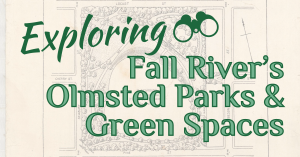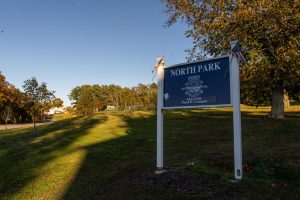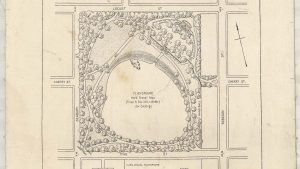Fall River is a city defined by its rich history. In the 1800s, Fall River benefited from the boom of the textile industry. The community prospered as the local mill owners and entrepreneurs grew more and more wealthy. In this time, Fall River blossomed from a cluster of small villages to a bustling city. Schools, businesses, streets and homes were constructed to meet the needs of its growing population.

Among these new editions to Fall River’s neighborhoods were parks. With many residents working long hours indoors in mills, it was important to provide open recreational spaces to support the health and happiness of Fall River’s neighborhoods.
The Fall River Commission on Park Improvements, later established as the City’s first Parks Commission, hired Frederick Law Olmsted and his firm to design several parks and green areas in Fall River. Olmsted, now known as the father of American landscape architecture, had achieved fame for his work designing New York City’s Central Park. Twelve years after Central Park’s successful construction, Olmsted visited Fall RIver in 1870 to make plans for the City’s recreational spaces.
The work of Olmsted, and his sons who later took on the business of running the Olmsted firm, were designed to highlight Fall River’s natural resources and to provide residents and visitors with serene retreats from the crowded urban neighborhoods nearby. Today, these historic parks have been preserved to maintain the original vision of Olmsted, and are beloved by visitors who respect his work to this day. Many upgrades have been made to the parks, making them a destination for young families and history buffs alike.
There are three major Olmsted parks in Fall River, alongside several smaller projects they completed in Fall River. Read on to discover the unique charm each one contributes to the city and consider making a stop to each one!
Kennedy Park (Broadway & Bradford Avenue)

Kennedy Park, originally named South Park, is a testament to Olmsted’s ability to transform a landscape into an engaging public space. With its expansive lawns, playgrounds, and sports facilities, the park caters to a diverse range of recreational activities. The design was meant to encourage community gatherings and fosters a sense of connection among residents.
The park was designed to highlight the views of Mount Hope Bay from Fall River’s hilly terrain, best exemplified by the lookout that still stands at the center of the park. Near the lookout is an accessible playground, frequently used by neighborhood children.
The park was renamed in 1963 after the assassination of John F. Kennedy, who had spoken at South Park while campaigning for U.S. Senator, one of his multiple visits to Fall River in the 1950s. Kennedy Park is now listed on the National Register of Historic Places.
North Park (President Avenue & Highland Avenue)
 Nestled in the northern part of Fall River, North Park is a green haven that unfolds across 40 acres of rolling landscapes. It was designed as “a neighborhood park located between two distinct types of community — a residential district of good character along Highland Avenue, and a poor tenement-house district.” After its creation, it offered outdoor “gymnasiums” to both men and women, a field house and wading pool, connected by winding paths through groves of deciduous trees.
Nestled in the northern part of Fall River, North Park is a green haven that unfolds across 40 acres of rolling landscapes. It was designed as “a neighborhood park located between two distinct types of community — a residential district of good character along Highland Avenue, and a poor tenement-house district.” After its creation, it offered outdoor “gymnasiums” to both men and women, a field house and wading pool, connected by winding paths through groves of deciduous trees.
Similar to Kennedy Park, the park was designed by Olmsted to highlight the view visible from Fall River’s hilly terrain. Paths were carefully planned out to give walkers an ever changing view of the neighborhood and river below.
Today, it is well known as a beloved destination for winter sledding and features a modern playground in its Southwest corner.
 Ruggles Park (Seabury St & Locust St)
Ruggles Park (Seabury St & Locust St)
In 1868, the city of Fall River, Massachusetts purchased a section of farmland, known then as Ruggles Grove. Before the Olmsted firm redesigned the space, many trees were gone and the park was in need of a major facelift.
Olmsted Brothers’ design included a ball field, “little folks’ playground”, and gently curving paths. They refashioned exposed ledges into a retaining wall. The park included a central pond, now gone, surrounded by Olmsted’s signature winding walking paths. Benches were strategically placed to provide visitors with ideal spots to relax and enjoy the scenery.
While the Olmsted firm was in town for these three major park projects, they were frequently contacted by the City and various community leaders who asked them to design and landscape other, smaller spaces in Fall River. They include:
First Congregational Church (Rock St)
In a departure from traditional park designs, the Olmsted Brothers were commissioned to provide a planting and landscaping plan for the First Congregational Church in 1913. They were commissioned by wealthy patron Sarah Submit Brayton, who gifted the church to the city. This collaboration highlights Olmsted’s versatility in incorporating his design principles into various urban projects, even those as small as the surrounding footprint of a church. The plan enhanced the church’s surroundings, creating a harmonious blend of stunning gothic architecture and nature.
Cathedral of St. Mary of the Assumption (Second St)
Another noteworthy project influenced by Olmsted’s design principles is the Cathedral of St. Mary of the Assumption. The Olmsted firmed designed the grounds of the cathedral, another of Fall River’s iconic gothic landmarks.
The cathedral and its surroundings showcase the enduring impact of Olmsted’s vision on the cityscape. The careful consideration of greenery and landscaping contributes to the cathedral’s serene ambiance, offering a peaceful retreat for reflection and contemplation.
Albert Bradbury Green (Stafford Rd & Coral St)
When the City of Fall River began preparing to pave one of its new major roadways, Stafford Road, they contracted the Olmsted firm to create a plan for a small patch of land adjacent to the new road. The design was done while the architects were in town to work on the South Park (Kennedy Park) project. While the footprint of Albert Bradbury Green is small, it was designed with several signature Olmsted features in place- including strategically placed benches for residents to sit and enjoy.
Durfee Green (Highland Ave & High St)
Another small signature project the Olmsted family worked on in the middle of their other, larger Fall River projects is the Durfee Green. This small, triangular green space was nestled in Fall River’s affluent Highlands neighborhood and is now well known for its sign welcoming passersby to the “Historic Highlands”.
Today, the Durfee Green is frequently used by walkers and features trees and plants that bring a touch of natural beauty to the stunning Victorian architecture of the surrounding area. Despite its small size, the clustered trees provide a pocket of serenity and residents can often be seen enjoying the view from their benches.
